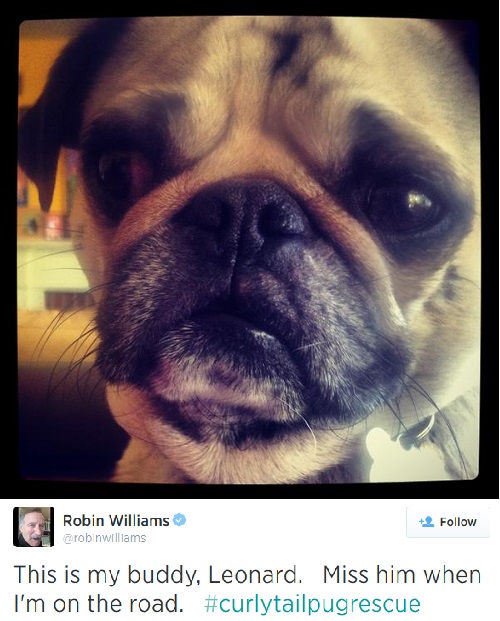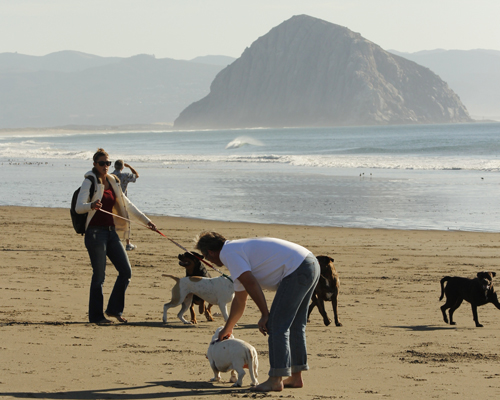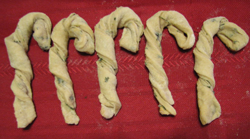Robin Williams Leaves Behind Family and Pug, Leonard
An icon has died today and yes, I realize we don’t typically cover this type of celebrity news. But I could not help but feel compelled to write about and pay some kind of tribute to this amazing talented and unique, actor, comedian, father, husband and dog lover.
Various new sources popped up onto my screen, reporting the same sad news that less than a mile from my own home, Robin Williams was found dead in his house in Tiburon, California. According to law enforcement reports, the 63-year-old, apparently took his own life.

Something not everyone may know is that Robin Williams was a dog lover, or rather, had a dog that he loved and was also a supporter of dog rescue. His Pug, “Leonard Bean” who was adopted from the Curly Tail Pug Rescue in New York city was regularly featured on the comedians twitter account.


“I also have a gay rescue pug called Leonard, who I take for walks because I am very secure in my sexuality. He has a boyfriend and they are planning to adopt a Siamese kitten together. We’re very modern,” Williams says in a interview with the Telegraph.
In an AmA Williams told reddit, “for pure loyalty, there is nothing like a Pug.”
The two often donated images to rescues including a version of this one which was featured in the August calendar of Tony LaRussa’s Animal Rescue Foundation.

Dog-Friendly Vacations That Will Make You Feel Like an Excellent Person
Earth Day might have you thinking how you can make a difference. While it’s always good to fit being green into your daily routine, have you ever considered a green vacation? Most people look at vacations as a way to escape their day-to-day and indulge, but what if there was a way to relax and give back all at the same time?

“Stewardship Travel offers visitors a lighter touch than a high intensity volunteer vacation,” explains Stewardship Travel Director and Diane Strachan. “For instance, WineCoastCountry’s Stewardship Travelers can pair a luxury spa visit with a brief dog friendly beach clean-up, followed by wine tasting from a Stewardship Traveler vintner that invites dogs, fine dining (without your dog) and a donation to the Pacific Wildlife Care Foundation.”
This mix means you can pamper yourself, your dog, and mother Earth at the same time – what could be better?

Each offers activities where dogs are invited to join their owner in demonstrating their philanthropic side:
Avila Beach and Valley – Stewardship Traveler dogs (especially retrievers!) and their owners can visit Avila Beach and pick up a Stewardship Beach Cleanup Kit at participating lodging properties to look for flotsam, jetsam, and plastic litter harmful to wildlife (best to explore the beach after storms). Avila has a special dog run beach north of town. Dogs are also welcome on the public beach before 10 a.m. and after 5 p.m.
Cayucos – Stewardship Traveler Dogs may accompany Stewardship Traveler owners on the dog friendly beach in Cayucos and help pick up the poop left behind my not so caring dog owners. Often times good intentioned people forget their green bagged dog poop on the beach. Poop bags are to be found at almost every beach access point in Cayucos.
Lopez Lake Recreation Area – Leashed pooches can join their guardians at one of the top choices for camping and leisure trips featuring 22 miles of shoreline, there’s something for everyone: camping, fishing, boating, skiing, sailing, windsurfing, picnicking, hiking, equestrian trails, mountain biking, canoeing, bird watching, hanging out with your dog, and so much more. Dogs cannot swim in the lake but can take the natural history boat cruise.
Pismo State Beach – From late October to February, leashed dogs and their guardians can marvel as thousands of black and gold Monarch butterflies cluster in the limbs of a Eucalyptus grove at Pismo State Beach, providing an amazing glimpse of nature in all her vibrant glory. This colony, easily accessible from Highway 1, is one of the largest in the nation, hosting an average of 50,000 butterflies every year.
San Luis Obispo Botanical Garden – Leashed canines are invited to the Botanical Gardens (although not during activities or events.) Featuring the diverse plant life of the Mediterranean climate zones of the world, this Botanical Garden provides opportunities for education, recreation, conservation and research. Through special programs and facilities, the Garden fosters an appreciation and understanding of the relationship between people and nature, and encourages a sense of stewardship toward the environment.
Dog Anal Gland Care
You know all that doggy butt-sniffing that we humans seem to find either appalling or hilarious? Ever ask yourself what that’s all about?

Healthy anal glands express, or empty, this fluid when the dog has a bowel movement. Unfortunately, some anal glands don’t work as they should because of inherited malformations, or because of a history of poor-quality foods that produce poor-quality bowel movements.
If the anal glands don’t empty properly, they can become impacted, making bowel movements difficult or painful, and potentially leading to infections or abscesses.
It’s not uncommon for a rescued dog to have a history of anal gland problems. Your dog may damage the delicate tissue around his anus in his attempts to relieve his own discomfort, so if you see him biting at his butt, or scooting it along the ground, take him to the vet.
Impacted anal glands can often be relieved by manually expressing, or squeezing out, the fluid they contain. This is a very smelly process, but if you’re game you can have your vet or groomer teach you how to do it. Most people whose dogs need their anal glands expressed periodically prefer to pay to have it done.
If your dog’s anal glands get impacted frequently, ask your vet to recommend a high-fiber diet to create bulkier stools. If that doesn’t work, and if your dog has repeated infections or abscesses from impaction, the anal glands may need to be removed.
Jean Dodds Trailblazer for Veterinary Care

Veterinarian W. Jean Dodds, DVM, is an internationally recognized expert in hematology and immunology, but that description is superficial at best. Dodds has been an iconoclast ever since she applied to veterinary school in 1959, at a time when few women were encouraged to enter the profession.
After graduating with honors from Ontario Veterinary College, she went about changing the face of veterinary medicine in the areas of hematology, immunology, endocrinology, nutrition, holistic medicine and animal welfare.
She was a pioneer and leading voice in the effort to revise vaccination schedules and curb overvaccination of pets. She has earned a long list of honors, including being named Woman Veterinarian of the Year and Holistic Veterinarian of the Year.
Dodds is the founder of the Garden Grove, Calif.-based Hemopet, which is an animal blood bank, rescue and adoption center for retired racing Greyhounds, and a specialty veterinary diagnostic laboratory. Before being placed in adoptive homes, Hemopet’s Greyhound blood donors provide canine blood components, and the bank provides blood supplies and related services throughout North America.
At an age when most people are thinking of retirement, if they’re not already there, she is works tirelessly to help the profession and the animals she loves.
Q: Your father was a doctor and he came from a family of medical professionals. How did that influence your choice of profession, and what drew you to veterinary medicine instead, especially when that was, at the time, such a difficult profession for women to enter?
A: I guess the medical leaning was there because of my family background. Most of the women were nurses and the men were physicians, of course, but when I was finishing high school my father said, “You don’t want to be a vet. It’s not very scientific. You need to be a pediatrician if you don’t want your patients to talk to you.” I insisted. So he took me down to the Ontario Veterinary College when I was in grade 11 and it turned out it was the most modern veterinary school in the world at the time. Everything looked like a human hospital: green scrubbies and sterile surgery and everything.
Instead of turning me off veterinary medicine, it turned me onto veterinary medicine even more. I filled out an application to enter the school. You had to get perfect grades and of course I was so naive I didn’t even worry about that. Talk about chutzpah. I just thought, “Well, if I have to get perfect grades, I’ll get perfect grades.” I had to do farm experience because I was a city girl, so I worked two summers milking cows by hand in order to qualify to get into the college.
After my first year, I came home for the summer, and he started asking me, pointing to different parts of his body and saying, “What are the veins and nerves and arteries?” and of course I’d just done anatomy so I could reel it off, and he said, “And you learn all the differences between all the different species?” and I said yes, and he said, “Oh my god, it’s much more difficult than human medicine.”
Q: You established the first nonprofit national animal blood bank. What pricked your interest in veterinary transfusion medicine?
A: I was on the East Coast in Albany, N.Y. I was in charge of the human blood program for the state of New York right at the time when AIDS and blood safety and everything became so important. I was a hematologist by training anyway as a veterinarian, and so I had to manage the regulatory issues for blood transfusion safety in the state of New York, including New York City, and I was therefore attending the regional Red Cross meetings.
I was coming home one night from one of them and I thought, “Why don’t we have a similar kind of blood bank just for animals?” I decided (the logo) would be a heart-shaped life preserver, which I called Pet Lifeline, and then I had to think of a name for the company that was a little bit more formal and that’s how I came up with Hemopet.
Q: How did you first become interested in the science of immunology, and what made you think, “Hmmm, maybe we need to take a look at the frequency of vaccination?”
A: I think that when you’re in hematology, you’re also in immunology. The two specialties sort of go together. When I started studying immunology, I realized that one of the things that was causing, or that appeared to be causing, problems was the fact that the animals would crash hematologically and immunologically after they received vaccinations. I don’t mean anaphylaxis, but within three days to 30 days after vaccination, these animals were all coming up with weird blood and immune dysfunctional problems and that’s how I started looking at vaccinations and whether we should be giving as many as we do, especially when we don’t do that in people.
Q: You were a leader in promoting the idea of more limited and less frequent vaccinations, spotlighting serious health effects of overvaccination. What’s happening with that today, and who is leading the change, veterinarians or pet owners?
A: Both the pet-owning public and veterinarians are finally starting to seriously embrace the need for a more limited “core” vaccine approach, and less frequent vaccination boosters Ñ once the puppy or kitten has received an appropriate vaccination series. Vaccine titer testing is also becoming more accepted as an alternative to automatic adult booster vaccinations, except for rabies, which is generally required every three years by law.
Q: Dogs also can suffer severe adverse reactions from rabies vaccinations and you are at the forefront of efforts to show that a rabies vaccine is effective for at least five years, and possibly seven years. To promote this research you are one of the founders of the Rabies Challenge Fund, which raises money to cover the cost of a seven-year rabies vaccine challenge study, as well as to finance a study of adjuvants used in rabies vaccines and establish a rabies vaccine adverse reaction reporting system. How far along is the RCF?
A: It’s complicated. We’re in our sixth year of the five- and seven-year trials, so the five-year trial has finished. Ronald Schultz, PhD, is conducting those studies through the University of Wisconsin Foundation, although the animals are not there. Nobody in the study is paid other than the people who care for the animals, so we all volunteer our time, including Dr. Schultz and the University of Wisconsin.
What’s happened so far is we’ve got all the vaccine titers done serially throughout the challenge studies for the five-year trial. We have not yet released the information on these results. We’ve not done any actual viral challenges at this point. We’re looking at the vaccine titer results for the five years and following up from there.

A: When I started looking at the things that regulated the blood and the immune system, based on my background in hematology and immunology, I realized that a lot of it is controlled by the master glands of the body, namely the pituitary gland and the thyroid gland. Because we really can’t measure pituitary gland output efficiently, I decided, “Well, we have to then look at what the thyroid does to regulate the rest of the body as a master gland.”
When I started looking at that, not coming from that background, I had a broader, more wholistic perspective, and I think it allowed me to see that we really weren’t looking at this from the basis of breed differences or age differences or anything else.
Q: How did you develop your diagnostic assessment methods of thyroid function and the thyroid panel that you offer at your lab? Can you explain the technology behind the diagnostics and lab tests?
A: We have four patents on our novel “green” thyroid testing. We’re the only lab that uses only nonradioisotopic methods for measuring the complete thyroid antibody profile using novel methodology. Although some similar assays are available at other labs in the U.S. and Canada, the technology that we use is a trade secret and does not come from North America.
My commitment was if we were going to start our own in-house laboratory for specialty testing, we’re not going to use isotopes. I did not want to bring them into the lab because of the environmental concerns, so we developed this technology over a period of time and then we started our own testing in this niche specialty in 2009. We also are the only lab that uses a cumulative age- and breed-specific database to interpret our results based on the age and breed type of the animal being tested.
Q: Do you think autoimmune thyroiditis is more common than it used to be, or are we just better at diagnosing it? What are some of the early signs that owners and veterinarians should be aware of?
A: Basically, both answers are correct. We are more aware now of the need to test for thyroiditis, particularly among the purebred dogs that are being used for breeding that are commonly affected. We’ve got 25 to 50 breeds that have a relatively high frequency of this condition. We also know that thyroid testing today is better than it used to be because we didnÕt have the thyroid autoantibody tests that we have now to look for thyroiditis.
The most important early clinical signs are unusual weight gain (despite) normal intake of food and behavioral aggression or weird behaviors: the animal becomes suddenly submissive, or it becomes wholly different in behavior. This can happen around puberty anywhere between, we’ve seen 7 months but typically 10 months to 11/2 years, which is much earlier than we used to see hypothyroidism a decade ago. Probably partly because of the environmental changes we have with the chemicals and the depletion of the ozone layer, overvaccination issues, overuse of pesticides on lawns and shrubs and bushes.
The most important thing for the clinical veterinarian is that — and this is not taught in my view accurately at the veterinary school level or the continuing education credit level — veterinarians are looking for fat and lazy hate-the-cold dogs with bad skin and coat. That only occurs after 70 percent of the thyroid gland or more has been damaged. We’re not taught to look for the early clinical and behavioral signs of thyroid dysfunction that present prior to the eventual 70 percent destruction of thyroid output and its attendant classical clinical signs.
Q: One of your other interests is nutrigenomics. Can you talk a little bit about what that is and what changes we might see in pet foods in the future?
A: Nutrigenomics is a relatively new term that was coined around 2002. (It explains) that certain foods can change the expression of one’s genes, whether you’re a person or an animal, and that each individual person or animal has what we call a molecular dietary signature. There are specific foods that that individual should eat to promote health and well-being and to prevent chronic disease. Nutrigenomics basically is the concept of individualized functional foods.

Q: What are some of the other new diagnostics and technologies that you are excited about or involved with?
A: Well, the only new thing that we’ve done, and we’ve done it now for about 18 months, is Nutriscan, which is our salivary test for food sensitivity and intolerance. It’s the only one available in the world for animals. We (have it for dogs); we will be starting with cats sometime soon, and next year if things go as planned, we’ll be doing the horse.
We’ve done about 4,000 Nutriscan tests. It’s very easy because the sample is stable for 30 days, so people from all over the world are doing the tests and sending us samples (in the mail), so much so that we’re actually talking about building out a part of our laboratory now to make a special facility to automate the technology here because it’s very labor-intensive. So we now have 24 foods in our test profile. The results are just amazing, totally amazing.
Q: Can you share one or two examples?
A: One example was a Leonberger that had suffered from chronic diarrhea for four years, despite frequent dietary changes and therapy. After running the Nutriscan testing, the offending food intolerances were identified and eliminated from his diet. Within three days and ever since then, his bowel movements have been completely normal.
In a second case, the dog was constantly scratching and itching in a frantic manner for several months, and would keep the owners up at night. After Nutriscan testing, the only reacting foods were quinoa and salmon. When I related that to the owner, she was amazed because she had been baking quinoa and salmon cookies for the dog as treats! Eliminating these treats solved the itching.
Q: Over the years, your work has been very controversial. When I wrote about vaccinations a few years ago, I remember getting an angry letter from a veterinarian wanting to know why I would quote someone who wasn’t even an immunologist. Leaving aside the fact that veterinary medicine doesn’t have an immunology specialty, how do you respond to those people, and why do you think you make them so angry?
A: We still have many arrows in our backs, Ron Schultz and I. They pass us by now because there’s no room. We laugh about that. But you know, we were talking years before the concept of overvaccination even became acknowledged. What really changed the industry was when cats got tumors at the vaccine injection site and then dogs did also. Even though we’ve known long before that about the adverse reactions that can occur, that really galvanized the veterinary medicine throughout the world to realize that vaccines were not sterile water and that they could stimulate a lot of immunologically challenging conditions.
I think maybe, you know, people don’t like change. It’s the same thing in human medicine. I would be just as controversial if I was a physician. That’s because I’m challenging people to look beyond the envelope. When you do that, if you get highly visible, as I am today, even people who don’t understand, don’t know who you are, immediately don’t feel comfortable with trying to change what they think isn’t broken. We tell people, “Please don’t be upset if you were doing things 20 years ago or even 10 years ago that are no longer considered the best thing to do in medical care for animals today. It’s not your fault we didn’t know about it. Now that we know about it, let’s move forward and change.”
Puppermint Dog Treats

An added bonus, the peppermint and parsley help with bad breath, which will thrill your guests.
Ingredients:
1 cup flour
½ tsp salt
1 tablespoon parsley
1 ½ tablespoons flaxseed oil
¼ teaspoon peppermint oil
½ cup low-sodium chicken broth
Parchment paper
Directions:
Mix flour, salt, and parsley together in mixer.
Add flaxseed and peppermint oil, mix.
Add chicken broth; mix until all dry ingredients are moistened
Roll dough out on floured surface to a 1/8” thick sheet.
Cut into ¼ – ½” inch strips.
Fold strips in have and twist together, curving one end over to make a candy cane shape.
Place on cookie sheet lined with parchment paper
Bake at 375 for 15-20 minutes
Makes approximately 10 candy canes
Allow to cool thoroughly before giving to your dog!
What Dog Breeds Have Ears That Stick Straight Up?
Pembroke Welsh corgi
The Pembroke Welsh corgi – a favorite of the Queen of England – is known for having ears that point to the sky. This small, sturdy herding breed is described by the American Kennel Club as possessing ears that stand erect and are pointed at the tip. A cousin of the Pembroke is that of the Cardigan Welsh corgi, a breed that is generally differentiated from the Pembroke by its long tail. The Pembroke’s tail is short and/or is docked by its owners. While Cardigan corgis’ also have vertical standing ears, their pinnae is more rounded than that of the Pembroke.
Chihuahuas
As puppies, Chihuahuas are born with floppy ears that fold over. But by the time they are adults, Chihuahuas’ ears become pointy and radar dish shaped. This erect shape helps Chihuahuas get rid of excessive body heat and aids them in identifying predators. Chihuahuas generally don’t develop severe ear infections thanks to the design of their ears. However, their ear shape makes Chihuahuas more at risk for attracting foreign bodies.
West Highland White Terrier
The West Highland white terrier, also called a “Westie,” is a small breed with ears that stand up naturally. Like the corgi, Westies are compact, sturdy dogs who love people. Adults males measure about 11 inches in height and females stand about 10 inches. The breed was developed for the rigorous work of getting rid of vermin. While West Highland white terriers may seem like cuddly lap dogs, most do not have the patience to be held for long periods of time. They also are not a good breed for gardeners because of their propensity to dig.
Breeds With Cropped Ears
Some breeds known for having pointy, erect ears, do not derive the appearance naturally. Boxers, Great Danes and Boston terriers are all breeds who regularly have their ears cropped by their owners. Cropping refers to the surgical altering of a dog’s ears to achieve a distinctive vertical appearance. Some animal activists argue that the cropping a dog’s ears is akin to animal cruelty, while other dog lovers say a cropped ear prevents certain canal infections. Animal experts say dog owners should consider carefully whether to crop or not.
How to Build Trust With Your Adopted Dog
1Offer treats. Most dogs can’t resist the aroma of a tasty treat. This can be a great way to get the dog to come closer. However, you shouldn’t make sudden movements or the dog will become frightened and run. Instead, offer the treat in your palm and wait for him to come to you. If he doesn’t come, place the treat on the floor and take a few steps back. Once he gets a taste for the treat, offer another from your hand. When he gets used to coming to you, continue to hold your hand out after the treat is gone. When he places his head in your hand, gently nuzzle your hand against his fur. This will take time and patience, but can help make your pet less fearful.
2Spend time together. Many shelter dogs have been left behind by their owners and feel they can’t trust anyone. If you’re the type to be out and about a lot, take your dog with you as often as possible. Let him know you care about him and you’re not going to abandon him. When you do have to be away from him, leave toys and treats to keep him occupied until you return. During the first few weeks, you should try to limit any unnecessary trips that require you to be gone for too long.
3Approach the dog carefully. When approaching your dog to pet him or pick him up, do so slowly. You never want to lunge at a dog in an attempt to catch him. This will only scare him more and make it even harder to build trust. You want your dog to come to you of his own free will.
4Give the dog space. Don’t try to smother your dog with love on the first day. Give him a chance to get used to his new home and calm down. This may take a few days, but allowing him to become comfortable will make him more apt to trust you. In time, he will come to you for petting and cuddles on his own without being lured by the smell of tasty treats.
5Be patient. It takes time to build the trust of a shelter pet. Many adopted dogs were neglected or even abused by their previous owners. This can be emotionally scarring for the animal and needs to be considered when building a bond with your new pet.





